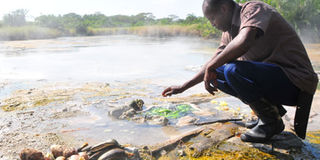Come cook food at Semliki hot springs

Ever dreamed of being in West Africa without actually going there? Ever wanted to photograph a king and his entire royal family for a fee? That dream comes true only if you visit Semliki National Park.
Hidden in a valley on the western side of the Rwenzori Mountains, the features of Semliki National Park give one a taste of Central and West Africa. Measuring 219sqkm and dominated by the eastern most extension of the great Ituri Forest of the Congo Basin, the park is one of Africa’s most ancient and bio-diverse forests; that survived the last ice age, 12-18,000 years ago.
The Semliki river that meanders in the lush valley forms the international boundary between Uganda and the DR Congo (DRC) and separates the park from the Ituri Forest of DRC. Teeming with hippos and crocodiles, the 160km long Semliki River carries runoff from the Rwenzori Mountains to Lake Albert and the Nile.
The park is home to a variety of Central African wildlife species and was once home to the local population of the now diminishing Batwa (pygmies) that originated from Ituri.
Today, the Batwa live in Ntandi settlement near the park and have not forgotten where their past ancestors and kings were buried inside the park. The Batwa perform rituals and dances for tourists around the areas where they once lived.
Semliki has 441 recorded bird species, representing 40 per cent of Uganda’s total bird species and 66 per cent (216) of the country’s forest bird species.
About 53 mammals 27 of which are large, call Semliki home. There are also 11 species that are endemic to the park. These include the pygmy antelope, two flying squirrel species and the peculiar water chevrotain (fanged deer).
For big game, there are forest elephants and buffaloes. The park is also a habitat for primates such as chimpanzees, baboon, grey-cheeked mangabey, black-and-white colobus, Central African red colobus, blue, red-tailed, de Brazza’s, vervet, and dent’s mona monkeys. Nocturnal primates are the potto and bush baby. Hippos and crocodiles colonised Semuliki River long ago.
Sempaya hot springs
But perhaps the most famous and mostly talked about sights and sounds of Semliki are its hot springs called Sempaya. The hot springs, one ‘male’ and the other ‘female’, bubble up from the depths to demonstrate the powerful subterranean forces that have been shaping the rift valley during the last 14 million years.
The park provides many nature walk exercises, including birding expeditions. It is also rated as one of the best birding sites with many rarities in Uganda.
For community visits, Ntandi village brings you face-to-face with Batwa and their King Nzito. Nzito is a unique king. He is paid upfront before pictures of him and his family are taken. He also makes sure his radio is well displayed in the pictures.
Cooking in Sempaya hot springs
The “male” spring, known as Bintente, measures about 12 metres while the ever furious “female” spring is called Nyasimbi, meaning “the female ancestors”. The female spring is a boiling geyser at 103°C. It is ever spurting bubbling water and steam up to two metres high and its fury can be seen several kilometres away. We cooked our meal composed of matooke and meat by inserting the meat wrapped in banana leaves into the spring. The meat was ready within one hour. Matooke fingers just take a few minutes to get ready. It is here that the locals used to prepare their meals.
Birds in the park
The birding list includes the nkulengu rail, yellow-throated cuckoo, piping hornbill, red-billed dwarf hornbill, black dwarf hornbill, white-crested hornbill, black-casqued wattled horbill, red-rumped tinkerbird, African piculet, white-throated blue swallow, yellow-throated nicator, leaf-love, swamp palm bulbul, lemon-bellied crombec, maxwell’s black weaver, crested malimbe, red-bellied malimbe, blue-billed malimbe, chestnut-breasted negrofinch, orange-cheeked waxbill.




